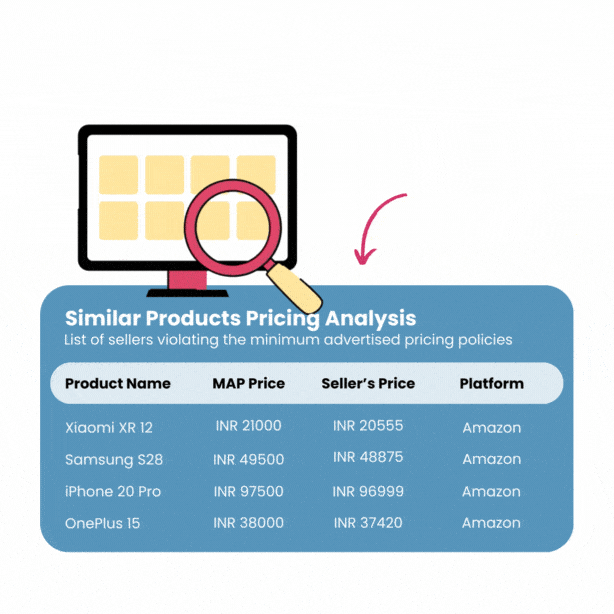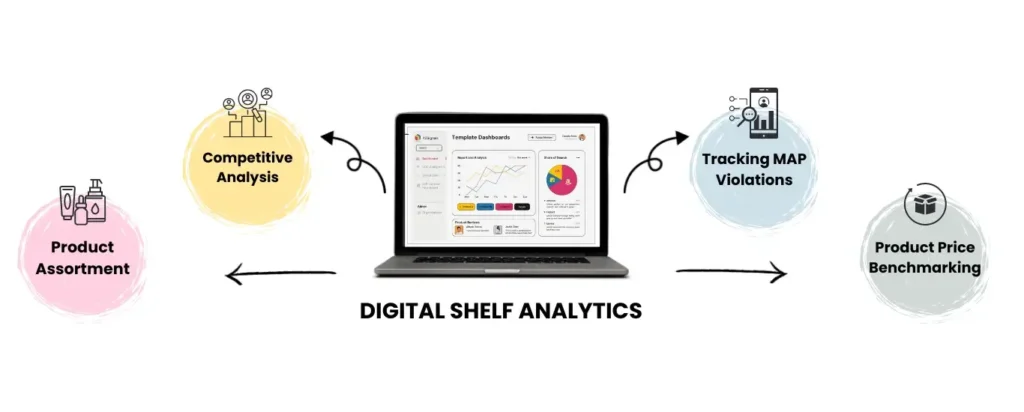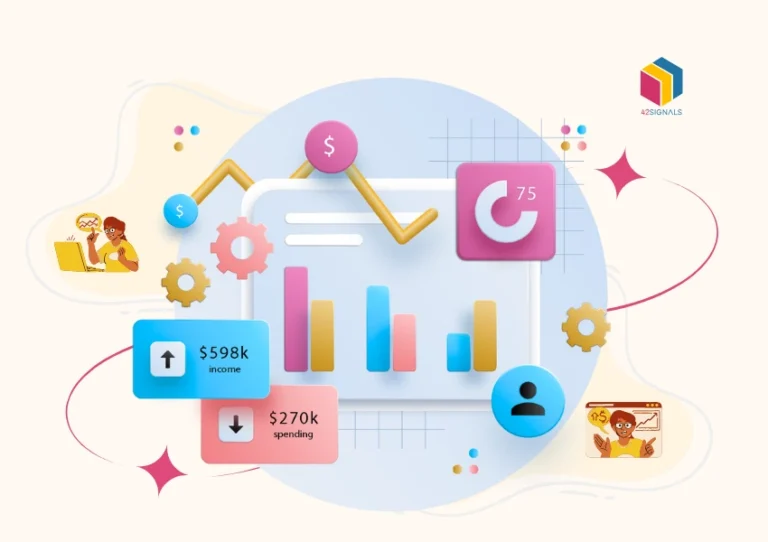Table of Contents
TogglePricing products today can feel akin to playing whack-a-mole. When one product’s price is adjusted, other products take a hit as competitors undercut you elsewhere. Customers generally expect a deal when shopping, and promotions can vanish quickly. That’s where pricing intelligence platforms can be of tremendous help.
Let’s understand how these tools operate, which features truly deliver value, and what this looks like on your actual balance sheet.
Why Guessing Doesn’t Work & Pricing Intelligence Platforms Are Needed
Remember setting a price and forgetting it for months? Those days are gone. Ecommerce moves at a brutal pace:
- Major players tweak prices millions of times weekly. It’s pure chaos.
- Getting pricing right can boost operating profits by 2-5%. Sounds small? That often means a 20-50% increase in overall profitability.
Image Source: Semrush
A pricing intelligence platform automates this critical grind and saves weeks of work and effort that can be taxing.
How Pricing Intelligence Platforms Actually Work
Think of tireless digital bloodhounds sniffing out data across competitor sites, Amazon, Walmart, eBay, and even your own listings. Here’s the step-by-step:
1. The magic behind the data
The magic behind the data uses two main tricks –
- Web Scraping: Websites are scraped to grab prices, stock status, images, descriptions, specs, and reviews. Runs constantly – often hourly for key items.
- API Connections: Direct data feeds (where allowed by retailers/marketplaces like Amazon Seller Central). Cleaner and faster, but not universal. Platforms fight site changes and anti-scraping tech constantly.
2. Making raw data easy
Is a ‘Samsung 65 QLED 4K Smart TV’ the exact same as a ‘Samsung 65-inch Q60C QLED 4K UHD Smart TV’? Pricing intelligence platforms use advanced machine learning to clean, standardize, and crucially match identical products. Without perfect matching, comparisons are worthless.
3. Cleaned data is used to reveal
- Your price vs. each competitor.
- The market’s average, lowest, and highest prices.
- How often prices jump (volatility).
- Who’s stocked out (your opportunity!).
- Active promotions (% off, BOGO, bundles).
- Often layered with other ecommerce data like Amazon keyword rank tracker or review sentiment analysis.

4. Your Intel Delivery
Insights hit dashboards or ping you. See price position maps, historical trends, and get instant alerts. If competitor X slashed product y’s price by 15%, or your product is out of stock on Amazon, competitor price tracking allows businesses to take immediate action.
Beyond Price Tags: Features That Deliver Real Punch
Basic tracking is the entry ticket. Real power comes from tools enabling retail price optimization and digital shelf analytics. Watch for these –
1. Precise Competitor Tracking
- Track all your competitors, not random sellers.
- Monitor prices across their site, Amazon, Walmart – wherever they play.
- Watch MAP violations if you enforce pricing policies.
- Spot the pricing rhythm – are they aggressive? Are they discount-positive?

2. Automated Repricing
- Automated repricing software can set rules based on live data. For example –
- Match the lowest price, but NEVER dip below $X.
- Alert me if I’m 8% above the market average.
- If Competitor Y drops their Amazon price, lower mine by 3% max every 4 hours.
3. Promo and Assortment Intel
- Pricing intelligence platforms can track if competitors offer percentage-off deals, BOGOs, and hidden coupons.
- Track bundle offers that mask true value.
- Identify new product launches and any stockouts.
4. Price Elasticity Modeling
Uses your historical sales + price data to predict demand changes. Answers:
- If I raise the price by 7%, will profits rise despite fewer sales?
- Price elasticity modeling finds elusive profit sweet spots for strategic retail price optimization.
5. Digital Shelf Health Scan
Your online presence is equal to your storefront. Track –
- Content gaps – missing or bad images, specifications, or even descriptions that kill conversions.
- Fill the search issues – can shoppers find you easily on Amazon or Walmart? Page 5 can mean you’re invisible.
- Understand reviews – are negative reviews tanking sales? This might force price cuts or signal fixes.
- Shelf space wars – How visible are you vs your rivals? Context matters for the right pricing power. True digital shelf analytics provides all this information in easy-to-understand dashboards.

6. Dashboards That Provide Value
A clean view of all the metrics that matter to you can help in understanding performance across categories and provide insights that you will actually use daily.
The Real Payoff of Pricing Intelligence Tools
1. Margin Rescue with Pricing Intelligence Platforms
- Stop Underpricing: Find items where you’re weirdly cheap vs. rivals. Raising prices here adds pure profit. Common finds: 5-15% margin lifts on key SKUs.
- Discount Smarter: Run promotions only where needed, using price elasticity modeling to protect profits. Know exactly how deep a discount drives volume profitably.
- Command Premiums: Spot items where competitors charge more. Justify your price with superior content/reviews (thanks to digital shelf analytics).
2. Sales & Share Surge
- Win the Amazon Buy Box: Price is king here. Staying competitive automatically boosts your share – a 10% increase can mean huge revenue jumps.
- Stay in the Game: React instantly when rivals drop prices on comparison-shopped items.
- Pounce on Competitor Fumbles: See a rival go out of stock? Slightly increase your price (capturing margin) or perfect your listing to grab demand.
3. Smarter Business Moves
Kill manual price checks. Retail Systems Research found this eats *15 hours/week* per manager. Get those hours back for strategy.
- Spot market trends (Is Competitor Z becoming a discounter?).
- Optimize assortments (What are rivals killing off? Where are gaps?).
- Negotiate better with suppliers using market price data.
- Price new products confidently based on real competitive landscapes.
- Brand Protection: Automatically enforce MAP pricing. Ensure consistent, accurate product info (digital shelf analytics) builds trust and supports your pricing.
How to Get Started
- Define Your Pain Point: What hurts most? Thin margins on key items? Losing Amazon Buy Box? Vague new product pricing? Set SPECIFIC goals/KPIs (e.g., “Increase Electronics margin by 3% in 6 months”).
- Know Your Space: Who are your true competitors? Track them relentlessly. Ignore the noise.
- Start Small & Win: Pick 50-100 critical SKUs first (bestsellers, high-margin, hyper-competitive). Prove value quickly, then expand.
- Build Your Pricing Guardrails: What’s your strategy? EDLP? High-Low? Value-Based? Use data to set repricing rules that align.
- Upgrade Your Tech: Ensure the platform talks to your online store (Shopify/Magento), inventory system (ERP), and product info hub (PIM). Smooth data flow = faster action.
- Share the Intel: Loop in Merchandising, Marketing, Finance. Digital shelf analytics help everyone fix problems beyond price.
- Tweak & Adapt: Review performance monthly. Are the rules working? Tweak them. Pricing isn’t set-and-forget.
Perfect pricing means nothing if your product page looks abandoned. That’s where digital shelf analytics becomes non-negotiable.
The Nightmare: You nailed the price on your premium blender. It’s 5% cheaper than the rival and wins the Amazon Buy Box. But on Walmart.com:
- Blurry main image.
- Key features are missing from the description.
- Wrong specs listed.
- 2.5-star reviews complaining about missing parts.
- Sales tank. Why? The digital shelf presence is a disaster despite the great price.
The Win: Combining price data with digital shelf analytics gives the full picture. You can:
- Justify Premium Pricing: Stellar content & reviews everywhere? That supports a higher price.
- Find the Real Sales Killer: Weak sales despite a good price? Analytics might show a terrible search rank or a review bomb – fix that.
- Prioritize Fixes: Get alerts on content errors or plunging ratings. Fix them fast.
- Control Your Brand: Ensure your product looks amazing everywhere it’s sold. Consistency builds trust.
Picking Your Platform Partner (Cut Through the Hype)
Lots of vendors exist. Choose wisely by asking:
- Data Truth: Which retailers/marketplaces do they cover accurately in your regions? Demand sample reports for your key products. How fresh is the data (hourly/daily)? Garbage data = garbage insights.
- Will Your Team Use It? Is the dashboard intuitive or a headache? What’s the learning curve? Clunky tools gather dust. Ask for a demo login.
- Feature Fit: Do you need price elasticity modeling? Or is rock-solid competitor price tracking + repricing enough? Don’t overpay for unused bells and whistles.
- Plays Nice With Your Tech? Smooth integration with your ecommerce platform, ERP, and PIM? Non-negotiable for efficiency.
- Support That Shows Up: Good onboarding? Responsive, retail-savvy support when you hit a snag? Or do they vanish after the sale?
- Clear Value, Clear Cost: Understand the pricing (per SKU? monthly fee?). Ask for ROI for retailers’ case studies in your niche.
Pricing Intelligence Platforms Aren’t Optional Anymore
Don’t wait for manual tracking to kick you in the gut. With pricing intelligence tools, you get –
- Confidence: Price based on live market data, not guesses.
- Speed: React to threats/opportunities in minutes, not days.
- Recovered Margin: Stop accidentally leaving money on the table.
- Sales Growth: Win more Buy Boxes, capture competitor slip-ups.
- Time: Reclaim hours lost to manual tracking.
Try 42Signals today to see all the pricing intelligence features in action.

Frequently Asked Questions
What is a price intelligence tool?
A price intelligence tool is a software solution that helps businesses track, monitor, and analyze competitor pricing in real time. It collects pricing data from multiple sources—like competitor websites, marketplaces, or online catalogs—and organizes it into actionable insights.
These tools allow brands and retailers to:
- Understand how their prices compare in the market
- Detect underpricing or overpricing risks
- Automate price adjustments
- Make data-driven pricing decisions
Price intelligence tools are especially useful in fast-moving sectors like electronics, fashion, and consumer packaged goods (CPG), where price transparency and competitiveness are critical.
What is a pricing platform?
A pricing platform is a centralized system or software that manages all aspects of pricing strategy and execution. Unlike basic pricing tools, a pricing platform often includes:
- Rule-based pricing automation
- Real-time market and competitor data integration
- Dynamic pricing capabilities
- Margin protection and profitability tracking
- Forecasting and pricing simulations
These platforms are used by brands, ecommerce retailers, and B2B companies to maintain consistent, profitable pricing across multiple channels. Some platforms also integrate with ERP systems, CRMs, or ecommerce storefronts for end-to-end control.
What is an intelligent pricing strategy?
An intelligent pricing strategy uses a combination of market data, customer behavior, competitor activity, and automation to set prices that optimize sales and profitability. It goes beyond static price lists and considers factors such as:
- Price elasticity and demand patterns
- Seasonality and inventory levels
- Competitor pricing movements
- Customer segments and buying behavior
- Real-time market trends
Intelligent pricing strategies often rely on machine learning or AI-driven algorithms to continuously refine pricing decisions based on live inputs. The goal is to stay competitive while maximizing revenue and profit margins.
What is an AI pricing solution?
An AI pricing solution uses artificial intelligence and machine learning to automatically recommend or adjust product prices based on real-time data. These solutions analyze massive amounts of inputs—like competitor prices, market trends, customer demand, and purchase history—to determine optimal price points.
Key benefits include:
- Real-time dynamic pricing adjustments
- Predictive modeling for promotions or discounts
- Increased pricing accuracy at scale
- Better alignment with customer value perception
- Improved margin control
AI pricing is especially powerful for large ecommerce stores or marketplaces with thousands of SKUs, where manual pricing would be too slow or inconsistent.







